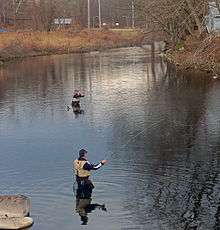Ramapo River
The Ramapo River is a tributary of the Pompton River, approximately 30 mi (48 km) long, in southern New York and northern New Jersey in the United States.

Course
The Ramapo river rises in Round Lake, a small freshwater lake in the Village of Monroe, New York in a mountainous area of central Orange County, New York, ] and flows southeast through the village where the river was dammed in 1741 for a sawmill and grist mill, to Harriman, Here a chemical plant, Nepera Chemical, was built, and while the plant has been dismantled, a superfund site has been designated at the location where barrels of toxic chemicals were buried. At Harriman, the river then turns south into western Rockland County, where it flows through the hamlet and town of Ramapo, New York, then into northern Bergen County, New Jersey. In New Jersey, it flows SSW, along the east side of the ridge of the Ramapo Mountains. The river flows into Potash Lake in Oakland and from there, into Pompton Lake in Pompton Lakes. The river that flows out of Pompton Lake, forming the border between Pompton Lakes and Wayne. The Ramapo forms a confluence with the Pequannock River along the border between Pequannock and Wayne, forming the Pompton River. A portion of the river's water is diverted to the nearby Wanaque Reservoir.

The river is a popular destination for fly fishing of trout. New York State Route 17, the Port Jervis commuter railroad line, and the New York State Thruway were all constructed in the valley of the river between Harriman and Suffern, New York.
History
Areas noted along the Ramapo River were inhabited by bands of the Lenape tribe, a large group who inhabited much of the coastal areas of the mid-Atlantic region. Some of their people retreated to the mountains under pressure from Dutch and English colonists. The Lenape occupied western Long Island, the areas of present-day metropolitan New York, northern and southern New Jersey and the Delaware River Valley, south through Pennsylvania into Delaware.
Many smaller archeological sites in Oakland, New Jersey have been found to have been inhabited by prehistoric indigenous peoples. Areas of Oakland also contain many areas where fossilized crustaceans can be found along the banks of the river.
Descendants of the Lenape include the Ramapough Lenape Indian Tribe (also known as the Ramapough Mountain Indians, recognized in 1980 by the state of New Jersey. Many have lived in Mahwah and Ringwood, New Jersey and Hillburn, New York since the late colonial period. They also intermarried with people of other ethnicities.
Torne Mountain (1,130 ft or 340 m; shown on topographic maps as "High Torne"), in Harriman State Park, overlooks the Ramapo Pass and remnants of the once-thriving Ramapo Iron Works. During the American Revolution, the Torne served as a lookout for British ship movements on the Hudson. Legend tells that Gen. George Washington lost his watch on the mountain, and it may still be heard ticking up there in a crevice of rock.
See also
- List of New Jersey rivers
- List of New York rivers
External links
| Wikimedia Commons has media related to Ramapo River. |